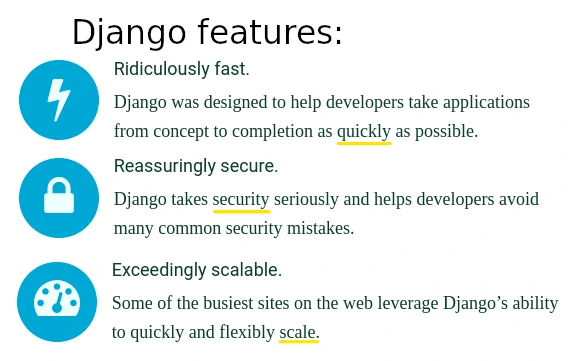Django is built for rapid development, and there are many reasons why you might choose to use it. It does a lot of things behind the scenes to make your life easier. It gives you a lot of choices for how your views and templates are structured, and you get to play around with the framework before you go live.
On the other hand, Flask is intended to be as little in your way as possible. It doesn’t do much to make your life easier, and it doesn’t offer as many options. The basic idea is that a “full stack web developer” should just write code. Everything else is taken care of.
Django
Django is the most commonly used Python framework for web development. It was first released in 2005, and has seen several new releases in the past few years. There are lots of tutorials, and many resources for learning the basics, including the official documentation.

If you’re more into application programming than web development, you can use Django without having to learn web development. It makes for a great framework for building backend services, such as an API or a Content Management System. It’s popular enough to have quite a few Python open-source web services written in Django, and that means that if you need a service written in Django, there will probably be a package for it in the Python Package Index (PyPI).
Flask
Flask is the least popular of the three, but the most lightweight. I personally like it better than Django because it makes it easier to learn web development. Django was intended to be very much the “full stack” framework, and Flask makes it easy to focus on web development.
In Python, you’ll find that there are many different methods for doing the same thing. Because Flask makes it easier to learn, it’s going to make it easier to learn those methods. The only “rule” of Flask is that all the code has to live in a single file. That way, you’re always going to have everything that you need for a web app in one place. If you’re learning Flask, I’d suggest sticking to something like Jinja2 as opposed to the more heavyweight DjangoTemplates.
Which to Choose?
If you’re looking to learn web development, there’s no one-size-fits-all recommendation. A few people might like one framework over another. You should probably learn more about them so you can better understand which one is better – Flask vs Django.
If you’re going to be building a large web service with Python, I’d suggest going with Django, because you can get the whole thing set up in about 5–10 minutes with Pip. It’s a very well-engineered, tested framework, which uses ORM for model managing. You’ll end up with everything you need to create a RESTful API or a website running the whole thing yourself.
If you’re just learning web development, and if you know absolutely nothing about web programming, then it’s a good idea to pick one of the less popular frameworks. It’s the easiest to pick up, and you’ll be able to use it to learn how to build web applications, which is what you want.
One great option for beginners is Flask. I mentioned earlier that this framework is pretty simple, but it also has a lot of powerful features built in to it. You can integrate SQLAlchemy for doing database requests, and Jinja2 for templating HTML. It’s also easy to set up, because the dependencies are all built in.
Summary
It’s easy to build web apps when you already know how to write HTML, JavaScript, and CSS. But if you’re an expert programmer or you’re working on a team of experts, that knowledge may not be enough. In this chapter, we covered the basics of server-side programming, using Python and Flask, so you can build your own web applications.
If you’re going to be building a new web service, or you want something with a lot of power and lots of features, you should look into Django. It’s much more powerful than Flask, but it also takes a lot of experience to get the most out of it. Flask is an ideal framework for web developers looking to build and learn something more than just a simple website.
